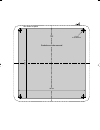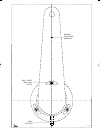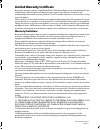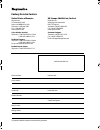- DL manuals
- Raymarine
- Marine Equipment
- ST5000 Plus
- Owner's Handbook Manual
Raymarine ST5000 Plus Owner's Handbook Manual
Summary of ST5000 Plus
Page 1
Distributed by any reference to raytheon or rtn in this manual should be interpreted as raymarine. The names raytheon and rtn are owned by the raytheon company..
Page 2: St5000 Plus
St5000 plus sailpilot owner’s handbook document number: 81136 -4 date: ma y 2001 136_3cov.P65 14/06/99, 10:16 1.
Page 3
136_3cov.P65 14/06/99, 10:16 2.
Page 4
Preface i rudder reference unit st5000 plus control head boat's electrical distribution panel sailpilot fluxgate compass seatalk instruments d3559-1 136_3pre.P65 14/06/99, 10:16 1.
Page 5
Ii st5000 plus sailpilot owner’s handbook raymarine , as part of its commitment to continuous improvement and updating, reserves the right to make changes, without prior notice, to the equipment, equipment specifications, and the instructions contained within this handbook. To the best of our knowle...
Page 6: Contents
Preface iii contents preface .................................................................................... Ix how this handbook is organised ...................................... Ix warranty ........................................................................... Ix safety information ......
Page 7
Iv st5000 plus sailpilot owner’s handbook chapter 3: advanced operation ......................................... 13 3.1 operation in track mode .......................................... 13 initiating track mode ................................................ 13 automatic acquisition ................
Page 8
Preface v 3.4 alarms ....................................................................... 24 seatalk failure ..................................................... 24 off course ............................................................ 24 wind shift ................................................
Page 9
Vi st5000 plus sailpilot owner’s handbook drive type .................................................................. 39 variation .................................................................... 39 autoadapt ................................................................. 39 latitude ..........
Page 10
Preface vii 5.5 sailpilot linear drive installation ............................... 54 mounting the drive unit ............................................. 55 drive unit cabling ...................................................... 56 5.6 nmea interface ...............................................
Page 11
Viii st5000 plus sailpilot owner’s handbook 136_3pre.P65 14/06/99, 10:16 8.
Page 12: Preface
Preface ix preface this handbook contains information on the operation and installation of your new equipment. In order to obtain the best performance from your autopilot, please read this handbook thoroughly. How this handbook is organised this handbook is divided into the following chapters: chapt...
Page 13: Safety Information
X st5000 plus sailpilot owner’s handbook safety information passage making under autopilot control is an enjoyable experience that can, if you are not careful, lead to the relaxation of the permanent watch. A permanent watch must be maintained no matter how clear the sea may appear to be. Remember, ...
Page 14: Chapter 1: Introduction
Chapter 1: introduction 1 chapter 1: introduction 1.1 overview the st5000 plus is a seatalk ® compatible autopilot available for sailpilot linear drive steering systems, which can also repeat instrument data in a programmable selection of data pages. The st5000 plus can share all data transmitted fr...
Page 15: 1.2 Extended Systems
2 st5000 plus sailpilot owner’s handbook 1.2 extended systems the st5000 plus is compatible with other raymarine seatalk instruments. Additional fixed and hand-held seatalk autopilot control units can be connected at secondary steering and control positions. 1.3 specification • power supply: 10 to 1...
Page 16: Chapter 2: Basic Operation
Chapter 2: basic operation 3 chapter 2: basic operation this chapter first provides summary diagrams of the key functions and screen layout. It then gives operating instructions for engaging the autopilot and using auto mode, changing the lighting, and displaying data pages. 2.1 key functions the au...
Page 17: 2.2 Display Layout
4 st5000 plus sailpilot owner’s handbook 2.2 display layout the following illustration shows all the elements, together with a brief description, that make up the st5000 plus autopilot lcd display. Rudder or steer direction indicator • the bar graph at the bottom of the display is normally a rudder ...
Page 18: 2.3 Using Auto Mode
Chapter 2: basic operation 5 2.3 using auto mode engaging the autopilot (auto) 1. Steady the vessel on the required heading. 2. Press auto . • in auto mode, the display shows the locked autopilot heading. Caution: passage making under autopilot control is an enjoyable experience that can, if you are...
Page 19
6 st5000 plus sailpilot owner’s handbook changing course in auto mode the +1 and +10 (starboard) and –1 and –10 (port) keys are used to change the locked heading, in increments of 1° and 10°, when the autopilot has control. Example: a 30° course change to port = press –10 three times. Dodging obstac...
Page 20: (Last Hdg)
Chapter 2: basic operation 7 returning to the previous locked heading (last hdg) if for any reason the vessel is steered away from the selected locked heading (for example, executing a dodge manoeuvre or selecting standby) you can return to the previous locked heading: 1. Press auto for 1 second. Th...
Page 21: Autotack to Starboard
8 st5000 plus sailpilot owner’s handbook autotack to starboard press the +1 and +10 keys together to tack to starboard. Autotack to port press the -1 and -10 keys together to tack to port . Off course alarm the off course alarm will sound if the locked autopilot heading and the vessel’s current head...
Page 22: Operating Hints
Chapter 2: basic operation 9 1. To cancel the off course alarm, press standby to return to hand steering. 2. Check whether your vessel is carrying too much sail, or whether the sails are badly balanced. Significant improvements in course keeping can usually be obtained by improving sail balance. Ope...
Page 23: Gusty Conditions
10 st5000 plus sailpilot owner’s handbook 3. Bring the vessel onto the new heading. 4. Select auto and let the vessel settle onto course. 5. Bring the vessel to the final course with 1° increments. Gusty conditions in gusting conditions, the course may tend to wander slightly, particularly if the sa...
Page 24: 2.5 Data Pages
Chapter 2: basic operation 11 • subsequent presses of the disp key cycles the possible illumination settings: l3, l2, l1, off, l1, l2, l3 etc. Where l3 is the brightest setting. The display times out to normal operation after 7 seconds of keypad inactivity. Pressing any other key before the 7 second...
Page 25
12 st5000 plus sailpilot owner’s handbook d3581-1 up to 7 data pages are available using the disp key. The number of pages, and the information displayed on each page, depends on the selections made in user setup (see section 5.1). • if the required data for a page is not available, dashes are displ...
Page 26: 3.1 Operation In Track Mode
Chapter 3: advanced operation 13 chapter 3: advanced operation this chapter provides information on: • operation in track mode • operation in vane mode (windtrim) • adjusting the response level and rudder gain • alarms 3.1 operation in track mode track mode is used to maintain a track between two wa...
Page 27: Automatic Acquisition
14 st5000 plus sailpilot owner’s handbook automatic acquisition automatic acquisition can only be achieved if the pilot is receiving cross track error and bearing to waypoint information (via seatalk or nmea 0183). It is initiated as follows: 1. Bring the vessel to within 0.1 nm of track. 2. Press a...
Page 28: Manual Acquisition
Chapter 3: advanced operation 15 previous heading • the display shows the new bearing to waypoint. Manual acquisition for manual track acquisition, when only cross track error data is available: 1. Steer the vessel to within 0.1 nm of track. 2. Bring the heading to within 5° of the bearing to the ne...
Page 29: Cross Track Error
16 st5000 plus sailpilot owner’s handbook cross track error cross track error (xte) is the distance between the current position and a planned route. This is displayed in nautical miles (nm), statute miles (sm) or kilometres, and is taken directly from your navigator. The large xte alarm sounds if t...
Page 30: Waypoint Arrival and Advance
Chapter 3: advanced operation 17 the autopilot takes account of vessel speed when computing course changes to ensure optimum performance over a wide range of vessel speeds. If speed data is available, the st5000 plus uses the measured vessel speed. Otherwise, the speed over ground (sog) or specified...
Page 31: Advance
18 st5000 plus sailpilot owner’s handbook skipping a waypoint – seatalk navigators only if you wish to advance to the next waypoint before you have arrived at the target waypoint, press track for 1 second. The waypoint advance information for the next waypoint is displayed. Advance while the waypoin...
Page 32: Verifying Computed Positions
Chapter 3: advanced operation 19 position confirmation at the start of a passage at the start of a passage you must always confirm the fix given by the position transducer, using an easily identifiable fixed object. Check for fixed positional errors and compensate for them. Verifying computed positi...
Page 33: Selecting Vane Mode
20 st5000 plus sailpilot owner’s handbook to use vane mode, the st5000 plus must receive wind information from one of the following sources: • seatalk wind instrument, connected to the st5000 plus via seatalk • nmea wind information • raymarine wind vane connected to a seatalk interface box selectin...
Page 34: (Last Wnd)
Chapter 3: advanced operation 21 returning to the previous apparent wind angle (last wnd) if for any reason the vessel is steered away from the selected apparent wind angle (for example, a dodge manoeuvre or selecting standby) you can return to the previous locked wind angle: 1. Press standby and au...
Page 35
22 st5000 plus sailpilot owner’s handbook • to cancel the alarm and retain the existing wind angle and new heading, press standby and auto together. • alternatively, to cancel the alarm and return to the previous heading, either: adjust the locked wind angle using the - 1 , +1, -10 and +10 keys; or ...
Page 36: Operating Hints
Chapter 3: advanced operation 23 operating hints • it is important to ensure that the amount of standing helm is minimised by careful sail trimming. • the headsail and mainsail should be reefed a little early rather than too late. • in vane mode the pilot will react to long-term wind shifts, but wil...
Page 37: Changing The Rudder Gain
24 st5000 plus sailpilot owner’s handbook changing the rudder gain press the +1 and -1 keys together for 1 second to display the rudder gain screen, and adjust the setting in the same way as for the response level. Refer to chapter 6, post installation procedures, for instructions on how to check th...
Page 38: Wind Shift
Chapter 3: advanced operation 25 wind shift windshift this alarm is activated when a change in the apparent wind angle of more than 15° is detected (see section 3.2, operation in vane mode). Large cross track error large xte this alarm is activated when the cross track error exceeds 0.3 nm (see sect...
Page 39: Waypoint Advance
26 st5000 plus sailpilot owner’s handbook waypoint advance next wpt? The waypoint advance alarm sounds whenever the target waypoint number changes, which occurs in the following circumstances: • automatic acquisition is selected by pressing track from auto • waypoint advance is requested by pressing...
Page 40: Shallow Alarm
Chapter 3: advanced operation 27 if you wish to set the watch mode, the watch screen must be con- figured as one of the data pages for display, as described in section 5.1. To set and control the watch alarm: 1. Select auto, track or vane mode. 2. Press the disp key until the watch data page is disp...
Page 41
28 st5000 plus sailpilot owner’s handbook 136_3c03.P65 14/06/99, 10:16 28.
Page 42: 4.1 User Setup
Chapter 4: customising the st5000 plus 29 chapter 4: customising the st5000 plus the st5000 plus provides setup and configuration options that are used to adjust the settings for the st5000 plus itself, the compass, and the autopilot. Note: you should perform the post installation procedures describ...
Page 43
30 st5000 plus sailpilot owner’s handbook +1 -1 or adjusting user setup values 136_3c04.P65 14/06/99, 10:16 30
Page 44: Heading Mode (Hdg Mag/true)
Chapter 4: customising the st5000 plus 31 compass deviation correction (swing compass) the compass deviation correction option allows you to correct the compass for deviating magnetic fields. The procedure must be performed as the first item in your initial sea trial, and is described in detail in c...
Page 45: Data Pages (Data Page)
32 st5000 plus sailpilot owner’s handbook mode bar standby rudder bar for systems with a rudder reference transducer auto compass heading error bar track xte bar vane wind angle data pages (data page) the next 7 user setup pages allow the settings for the data pages to be modified. These are the sea...
Page 46
Chapter 4: customising the st5000 plus 33 data displayed as course over ground cog speed over ground, knots sog kts cross track error xte distance to waypoint dtw bearing to waypoint btw rudder gain rudd gain response response watch watch universal time constant utc there are 3 depth pages and 2 wat...
Page 47: 4.2 Dealer Setup
34 st5000 plus sailpilot owner’s handbook • press disp to move on to the next data page selection screen, and repeat the selection procedure. Note: if a man overboard (mob) message is received by the autopilot, the btw and dtw pages will display the bearing and distance to the mob location, so it is...
Page 48
Chapter 4: customising the st5000 plus 35 +1 -1 or d3583-1a 136_3c04.P65 14/06/99, 10:16 35.
Page 49: Calibration Lock
36 st5000 plus sailpilot owner’s handbook feature options/ default new range setting setting calibration lock on or off off pilot type 5000 sail 5000 sail rudder gain 1 to 9 5 response 1 (autoseastate) or 1 2 (no autoseastate) turn rate limit 5 to 40 40 align rudder -7 to +7 0 rudder limit 15 to 40 ...
Page 50: Rudder Gain
Chapter 4: customising the st5000 plus 37 rudder gain this is the “power-on” rudder gain setting and should be adjusted to the setting which gives the best steering performance as described in chapter 6. Response this is the power-on response setting. The response level can be changed during normal ...
Page 51: Off Course Alarm
38 st5000 plus sailpilot owner’s handbook 2. Access the rudder limit screen ( rud limit ). 3. Set the autopilot rudder limit so that it is 5° less than the smallest (port or starboard) mechanical end stop angle. Off course alarm this feature controls the alarm that warns you if the autopilot is unab...
Page 52: Drive Type
Chapter 4: customising the st5000 plus 39 setting effect recommended for: off no trim correction 1 slow trim correction heavy displacement vessels, with full keel or transom rudder. 2 medium trim correction heavy displacement vessels. 3 fast trim correction moderate to light displacement vessels. 4 ...
Page 53: Latitude
40 st5000 plus sailpilot owner’s handbook set autoadapt to nth in the northern hemisphere, or sth in the southern hemisphere. You then need to enter your current latitude in the next setup screen, so that the st5000 plus can provide accurate course keeping by automatically adjusting the rudder gain ...
Page 54: Chapter 5: Installation
Chapter 5: installation 41 chapter 5: installation we recommend that you get an experienced professional, who is familiar with your boat’s primary steering system, to install your new autopilot. 5.1 planning the installation this chapter explains how to install and connect the following: • control h...
Page 55: Suppression Ferrites
42 st5000 plus sailpilot owner’s handbook • raymarine specified cables should be used at all times. Cutting and rejoining these cables can compromise emc performance and so must be avoided unless doing so is detailed in the installation manual. • if a suppression ferrite is attached to a cable, this...
Page 56: 5.2 Control Head
Chapter 5: installation 43 5.2 control head 110mm (4.33in) 11 5mm (4.53in) 91mm (3.6in) 24mm (0.95in) 17mm (0.67in) d3242-1 siting the control head is completely waterproof and should be sited where it is: • within easy reach of the steering position • protected from physical damage • at least 230 m...
Page 57: Surface Mounting
44 st5000 plus sailpilot owner’s handbook note: adjacent control heads, or instruments, must have a 6 mm (1/4 in) gap between them to allow sun covers to be fitted. Surface mounting to fit a surface mount control head: 1. Apply the surface mount template (supplied near the rear of this handbook) to ...
Page 58: Flush Mounting
Chapter 5: installation 45 flush mounting to fit a flush mount control head: 1. Ensure that the panel on which you intend to mount the control head is between 3 mm and 20 mm thickness. 2. Apply the flush mount template (supplied near the rear of this handbook) to the selected location and mark out t...
Page 59: Cable Connectors
46 st5000 plus sailpilot owner’s handbook cable connectors • all connections, except for the seatalk cables, are made via spade connectors. • when fitting the spade connectors, make sure the connector fits securely over the blade and not between the connector and its plastic insulating boot – incorr...
Page 60: Seatalk Cables
Chapter 5: installation 47 • if the supplied power lead is too short, the lead can be extended if required. The table shows the minimum acceptable cable sizes: cable length copper area awg up to 2.5 m (8 ft) 2.5 mm 2 14 up to 4.0 m (13 ft) 4.0 mm 2 12 note: correct cable size is critical for correct...
Page 61: Cable Types
48 st5000 plus sailpilot owner’s handbook cable types typical seatalk cabling d3392-1 seatalk bus power supply autopilot control head (rear) 5.3 fluxgate compass correct positioning of the fluxgate is crucial if ultimate autopilot performance is to be achieved. The fluxgate should, to minimise gimba...
Page 62
Chapter 5: installation 49 • to avoid deviation of both compasses, the fluxgate compass should be installed at least 0.8 m (2.5 ft) away from the steering compass. • the fluxgate compass must be positioned as far away as possible from large iron masses, such as the engine and other magnetic devices,...
Page 63
50 st5000 plus sailpilot owner’s handbook 6ft (1.8m) 4ft (1.2m) 4ft (1.2m) installing the fluxgate compass attach the fluxgate compass to a bulkhead using the four self-tapping screws provided. Vertical d193-1 note: a label is supplied to warn people that the compass is mounted behind or below the b...
Page 64: Cabling
Chapter 5: installation 51 cabling 1. Route the fluxgate compass cable back to the control head. 2. Connect the five core cable (colour for colour) to the compass terminals. D3282-1 5.4 rudder reference transducer a rudder reference transducer is supplied with the st5000 plus sailpilot. This device ...
Page 65: Control Dimensions
52 st5000 plus sailpilot owner’s handbook • the base height must maintain the correct vertical alignment of the transducer arm and tiller arm. • if it is more convenient, the transducer may be mounted upside down (logo downwards). • the transducer has a built in spring to remove any free play in the...
Page 66: Cabling
Chapter 5: installation 53 2. Dimension a should, ideally, be 140 mm (5.5 in) – changes within the limits shown will not degrade the autopilot performance but will slightly alter the scaling of the rudder angle display. 3. Use the self-tapping screws to secure the tiller pin to the tiller arm. 4. Cu...
Page 67: Caution:
54 st5000 plus sailpilot owner’s handbook 5.5 sailpilot linear drive installation the sailpilot linear drive is connected directly to the rudder stock at the specified tiller arm radius. 90 d1010-2 700mm (27.5in) 4 off fixing holes suitable for 10mm (0.4in) bolts 79mm (3.1in) 114mm (4.5in) 197mm (7....
Page 68: Mounting The Drive Unit
Chapter 5: installation 55 mounting the drive unit when siting the drive unit, please consider the following points: • the bracket can be attached to any horizontal or vertical surface • the drive unit can, if required, be installed upside down • the ball end fitting allows up to 5° of misalignment ...
Page 69: Drive Unit Cabling
56 st5000 plus sailpilot owner’s handbook drive unit cabling the sailpilot drive unit has electrical connections for both the motor and the clutch. Use a suitable cable (refer to the following table) to connect the drive unit to the st5000 plus control head (as shown). Cable length copper area awg u...
Page 70: 5.6 Nmea Interface
Chapter 5: installation 57 5.6 nmea interface st5000 plus will accept navigation data in the nmea format for use in track control and windvane modes. The required data formats are shown in the table at the end of this section. Cabling the nmea data port is on the rear of the st5000 plus and should b...
Page 71: Data Formats
58 st5000 plus sailpilot owner’s handbook data formats the following nmea 0183 wind and navigation data can be decoded by st5000 plus. Data nmea 0183 course over ground vtg, rmc, rma speed over ground vtg, rmc, rma cross track error apb, apa, rmb, xte bearing to waypoint apb, bwr, bwc, rmb distance ...
Page 72: 6.1 Functional Test
Chapter 6: post installation procedures 59 chapter 6: post installation procedures once you have installed the system, you need to confirm that the system is wired correctly and is also set up to suit your type of boat. This chapter provides instructions for the following procedures: • functional te...
Page 73: Operating Sense
60 st5000 plus sailpilot owner’s handbook operating sense the operating sense defines the direction the helm will be applied when a course change key is pressed or the vessel goes off course. Check the operating sense as follows: 1. Press auto . 2. Press the +10 key. The helm should move to produce ...
Page 74: Wind Transducer Interface
Chapter 6: post installation procedures 61 • the signals being received by the navigator are too weak for reliable navigation. Refer to the navigator handbook for further action. Wind transducer interface if the st5000 plus is connected to a wind instrument via its nmea data port or seatalk, then th...
Page 75: 6.2 Dockside Procedure
62 st5000 plus sailpilot owner’s handbook if the illumination does not switch on then a cabling fault exists in the seatalk cabling between the st5000 plus control head and the instruments/control unit. 6.2 dockside procedure the dockside procedure is only required if a rudder reference transducer i...
Page 76: Caution:
Chapter 6: post installation procedures 63 • automatic compass deviation correction • heading alignment adjustment • autopilot operation check • rudder gain adjustment note: the st5000 plus has a built-in calibration capability which enables it to be fine tuned to suit the individual vessel, its ste...
Page 77
64 st5000 plus sailpilot owner’s handbook to perform the deviation correction: 1. Make sure that the autopilot is in standby mode. 2. Press and hold the standby key for 2 seconds to display the user setup entry page. D3448-1 if cal lock is displayed, you need to turn off the lock feature contained i...
Page 78: Can I Cancel The Process?
Chapter 6: post installation procedures 65 what if i turn the boat too quickly? If you turn the boat too quickly for the compass to be corrected correctly, the text too fast will be displayed. Apply less helm to turn in a larger circle. D3452-1 can i cancel the process? You can abort the correction ...
Page 79
66 st5000 plus sailpilot owner’s handbook d3458-1 this shows the maximum deviation detected, and indicates that compass correction has been completed successfully. Note: if the deviation value exceeds 15° or a deviation value is not displayed at all, you should consider moving the fluxgate compass t...
Page 80: Checking Autopilot Operation
Chapter 6: post installation procedures 67 further heading alignment adjustment you should always check the compass alignment after swinging the compass. However, once the initial deviation correction procedure has been performed, you can make adjustments to the alignment as often as you wish, witho...
Page 81
68 st5000 plus sailpilot owner’s handbook 1. In clear water and with the autopilot in auto, alter course to starboard by 40° by pressing the +10 key four times. • at cruising speeds, course changes of 40° should result in crisp turns followed by an overshoot of no more than 5°. If this occurs the ru...
Page 82
Chapter 6: post installation procedures 69 4. Once you have determined the correct setting, change the default rudder gain setting in dealer setup, as described in chapter 4, customising the st5000 plus. 136_3c06.P65 14/06/99, 10:17 69.
Page 83
70 st5000 plus sailpilot owner’s handbook 136_3c06.P65 14/06/99, 10:17 70
Page 84: Chapter 7: Maintenance
Chapter 7: maintenance 71 chapter 7: maintenance general • in certain conditions, condensation may appear on the lcd window. This will not harm the unit, and can be cleared by switching on the illumination for a while. • never use chemical or abrasive materials to clean your autopilot. If the pilot ...
Page 85
72 st5000 plus sailpilot owner’s handbook 136_3c07.P65 14/06/99, 10:17 72.
Page 86: Chapter 8: Fault Finding
Chapter 8: fault finding 73 chapter 8: fault finding all raymarine products are subjected to a comprehensive test procedure prior to packing and shipping. In the unlikely event that a fault does occur with your autopilot, the following check list should help identify the problem and provide a cure. ...
Page 87
74 st5000 plus sailpilot owner’s handbook position information not received • navigator not transmitting the correct position data. The autopilot will not auto advance to the next waypoint • no bearing to waypoint information received from the navigator. A series of rotating dashes are displayed on ...
Page 88: Index
Index 75 index a advice 71 alarms 24 apparent wind angle adjusting 20 previous 21 auto mode 5 autoadapt 39 automatic deadband 23 automatic track acquisition 14 autoseastate 23 autotack 7 default angle 38 vane mode 22 autotrim default setting 38 b bar graph 4 c cabling 71 calibration 29–40 calibratio...
Page 89
76 st5000 plus sailpilot owner’s handbook display layout 4 dodging obstacles auto mode 6 track mode 18 vane mode 21 drive stopped alarm 25 drive type 39 e engaging the autopilot 5 f fault finding 73 functional test 59–60 g graph use 31 h hand steering 5 heading 7 heading alignment 31 heading alignme...
Page 90
Index 77 m maintenance 71 man overboard (mob) 27 manual steering 5 manual track acquisition 15 minimum deadband 23 n navigation data displays 11 navigation interface (gps, decca, loran) 60 next wpt 26 no data alarm 25 o off course alarm 8 default angle 38 operating modes 1 operating sense 60 p perfo...
Page 91
78 st5000 plus sailpilot owner’s handbook t testing autopilot operation 67 testing the system 59–60 tidal stream compensation 16 track acquisition 13 track mode 13–14 turn limit 37 u user setup 29 v vane mode 19–20 variation 39 w watch alarm 26 waypoint arrival and advance 17 wind shift alarm 21 win...
Page 92
Machine hole 90mm (3.54in) diameter drill 5mm (3/16in) drill 5mm (3/16in) surface mount template d3441-2a 136_3tem.P65 14/06/99, 10:17 1.
Page 93
136_3tem.P65 14/06/99, 10:17 2.
Page 94
Shaded area to be removed top 109 mm flush mount template 114 mm 4 holes 6 mm diameter d4437-2 136_3tem.P65 14/06/99, 10:17 3.
Page 95
136_3tem.P65 14/06/99, 10:17 4.
Page 96
Rudder positioned amidships cable position drill three 3mm (1/8in) holes d3440-1 136_3tem.P65 14/06/99, 10:17 5.
Page 97
136_3tem.P65 14/06/99, 10:17 6.
Page 98: Warranty Limitations
Document number: 84064-8 april 2001 limited warranty certificate raymarine warrants each new light marine/dealer distributor product to be of good materials and workmanship, and will repair or exchange any parts proven to be defective in material and workmanship under normal use for a period of 2 ye...
Page 99: Factory Service Centers
Factory service centers united states of america uk, europe, middle east, far east raymarine inc 22 cotton road, unit d nashua, nh 03063-4219, usa raymarine ltd anchorage park, portsmouth po3 5td, england telephone: +1 603 881 5200 fax: +1 603 864 4756 www.Raymarine.Com telephone: +44 (0)23 9269 361...



































































































